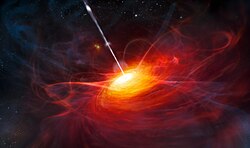ULAS J1342+0928

| ULAS J1342 + 0928 | |
|---|---|
 | |
同様のクエーサーのイメージ図 | |
| 星座 | うしかい座 |
| 分類 | クエーサー |
| 位置 元期:J2000.0 | |
| 赤経 (RA, α) | 13h 42m 08.10s |
| 赤緯 (Dec, δ) | +09° 28′ 38.61″ |
| 赤方偏移 | 7.54 [1] |
| 距離 | 29.36 Gly (9.00 Gpc) (共動距離)[2] 13.1 Gly (4.0 Gpc) (固有距離)[3] |
| ■Template (■ノート ■解説) ■Project | |
ULAS J1342 + 0928はこれまでに発見された中で、2番目に遠い位置にあるクエーサーであり、最古の超大質量ブラックホールを有している[1][3][4][5] 。赤方偏移はz = 7.54と観測されており、発見当時、最も遠かったクエーサーであるULAS J1120+0641の赤方偏移7を上回った[1]。このクエーサーはうしかい座に位置しており、超大質量ブラックホールは太陽の8億倍の質量であると報告されている[3]。
発見[編集]
2017年12月6日[1]、広域赤外線探査衛星[4]からのデータとチリにあるラス・カンパナス天文台のマゼラン望遠鏡、アリゾナの大双眼望遠鏡、ハワイのジェミニ天文台による地上からの観測データを用いてクエーサーを発見したと発表された。このクエーサーのブラックホールは宇宙誕生後の6億9000万年から存在しており、これは宇宙の年齢の138億年の5̤%にあたる[1]。
このクエーサーは暗黒時代の後の宇宙の再電離と呼ばれる時期に生まれた[3]。広範囲の塵とガスがクエーサーから銀河の星間物質に放出される様子が見つかった[6]。
概要[編集]
ULAS J1342+0928の赤方偏移は7.54と測定されており、実際の距離は地球から293.6億光年ほどである[1]。この天体は2021年にJ0313-1806が発見される[7]まで最遠のクエーサーだとされた。今日地球で観測できる光はビッグバンから6億9000万年以内にクエーサーから放たれ、これは現在から131億年前に相当する[3][8]。
このクエーサーの光度は太陽の4×1013倍と推定されている[1]。このエネルギーは太陽の 8×108 倍の質量を持つ超大質量ブラックホールによって生み出されている[1]。天文学者のリーダーのバニャドスはULAS J1342 + 0928について[9]、「このクエーサーは非常に明るく、追跡調査にとって非常に重要なサンプルであり、初期宇宙の研究にとって非常に重要なものになるだろう[3]。」と述べている。
意義[編集]
ULAS J1342+0928からの光は、宇宙が電気的に中性な状態から再電離される状態に変化する理論的に予測された時期の終わり頃に発せられた。クエーサーは宇宙の暗黒時代の終わりにおいて重要なエネルギーの源であることや、クエーサーは紫外線の輝度が高く宇宙の再電離過程の研究に適した天体であることから、暗黒時代から移行する前のクエーサーを観測することは理論家の大きな関心となっている[10][11]。 またこのクエーサーで見つかった超大質量ブラックホールは当初、宇宙の歴史の早い段階でのブラックホールとして予想されていたが、実際は予想された質量よりも重かった[4]。同様のクエーサーが発見されることはこれが初めてではないが、このような理由から今回の発見はブラックホール形成の理論の新たな課題となっている[12][13]。
関連事項[編集]
脚注[編集]
- ^ a b c d e f g h Bañados, Eduardo (6 December 2017). “An 800-million-solar-mass black hole in a significantly neutral Universe at a redshift of 7.5”. Nature 553 (7689): 473–476. arXiv:1712.01860. Bibcode: 2018Natur.553..473B. doi:10.1038/nature25180. PMID 29211709.
- ^ Wright, Ned (2016年4月24日). “Ned Wright's Javascript Cosmology Calculator”. UCLA. 2017年12月7日閲覧。
- ^ a b c d e f Choi, Charles Q. (2017年12月6日). “Oldest Monster Black Hole Ever Found Is 800 Million Times More Massive Than the Sun”. Space.com. 2017年12月6日閲覧。
- ^ a b c “Found: Most Distant Black Hole”. NASA (2017年12月6日). 2017年12月6日閲覧。 “"This black hole grew far larger than we expected in only 690 million years after the Big Bang, which challenges our theories about how black holes form," said study co-author Daniel Stern of NASA's Jet Propulsion Laboratory in Pasadena, California.”
- ^ Decarli, Roberto (2017年9月). “Rest-frame optical photometry of a z-7.54 quasar and its environment”. CalTech. 2017年12月6日閲覧。
- ^ Venemans, Bram P. (6 December 2017). “Copious Amounts of Dust and Gas in a z = 7.5 Quasar Host Galaxy”. The Astrophysical Journal Letters 851 (1): L8. doi:10.3847/2041-8213/aa943a.
- ^ “Astronomers discover oldest, most distant quasar and supermassive black hole 13 billion light years away (2021年1月13日)”. CBS News. 2022年1月25日閲覧。
- ^ Grush, Loren (2017年12月6日). “The most distant supermassive black hole ever found holds secrets to the early Universe - We're seeing how it looked when the Universe was a toddler”. TheVerge 2017年12月6日閲覧。
- ^ Bañados, Eduardo (2017年). “Eduardo Bañados - Bio/CV”. Carnegie Institution for Science. 2017年12月7日閲覧。
- ^ Matson, John (2011年6月29日). “Brilliant, but Distant: Most Far-Flung Known Quasar Offers Glimpse into Early Universe”. Scientific American. 2017年12月7日閲覧。
- ^ Willott, C. (2011). “Cosmology: A monster in the early Universe”. Nature 474 (7353): 583–584. arXiv:1106.6090. Bibcode: 2011Natur.474..583W. doi:10.1038/474583a. PMID 21720357.preprint of this paper
- ^ Davide Castelvecchi (2015年2月25日). “Young black hole had monstrous growth spurt”. Nature. 2017年12月9日閲覧。 “A black hole that grew to gargantuan size in the Universe's first billion years is by far the largest yet spotted from such an early date, researchers have announced. The object, discovered by astronomers in 2013, is 12 billion times as massive as the Sun, and six times greater than its largest-known contemporaries. Its existence poses a challenge for theories of the evolution of black holes, stars and galaxies, astronomers say. Light from the black hole took 12.9 billion years to reach Earth, so astronomers see the object as it was 900 million years after the Big Bang. That “is actually a very short time” for a black hole to have grown so large, says astronomer Xue-Bing Wu of Peking University in Beijing.”
- ^ “Discovery in the early universe poses black hole growth puzzle”. Phys.org (2015年5月11日). 2017年12月9日閲覧。 “Now, researchers from the Max Planck Institute for Astronomy (MPIA) have discovered three quasars that challenge conventional wisdom on black hole growth. These quasars are extremely massive, but should not have had sufficient time to collect all that mass. The astronomers observed quasars whose light took nearly 13 billion years to reach Earth. In consequence, the observations show these quasars not as they are today, but as they were almost 13 billion years ago, less than a billion years after the big bang. The quasars in question have about a billion times the mass of the sun. All current theories of black hole growth postulate that, in order to grow that massive, the black holes would have needed to collect infalling matter, and shine brightly as quasars, for at least a hundred million years. But these three quasars proved to be have been active for a much shorter time, less than 100,000 years. "This is a surprising result," explains Christina Eilers, a doctoral student at MPIA and lead author of the present study. "We don't understand how these young quasars could have grown the supermassive black holes that power them in such a short time."”
外部リンク[編集]
| 記録 | ||
|---|---|---|
| 先代 ULAS J1120+0641 | 最も遠いクエーサー 2017 – 2021 | 次代 J0313-1806 |